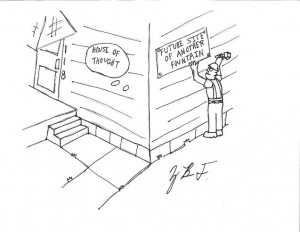
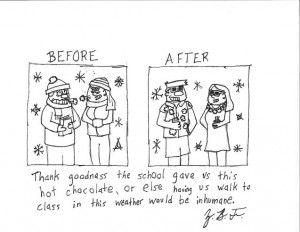
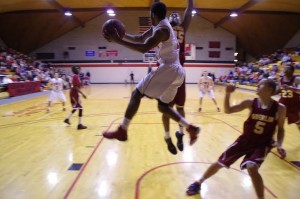
It was a matchup that had been played twice before, and this time wasn’t very different from the others.
But this round was worth more – after their third win against Oberlin College, the Ohio Wesleyan men’s basketball team will advance to the North Coast Athletic Conference’s tournament semifinals against DePauw University.
The women’s basketball team was also playing at Oberlin during this game, and won 75 to 58 with a career-high 24 points from junior Emily Julius.
Like the men’s team, they’ll face DePauw next, but the OWU women’s team lost against them 74-69 in their previous matchup.
The men’s game will be this week on Feb. 27 at 8:30 in Branch Rickey Arena.
In the regular season, DePauw took on the OWU men’s team twice, and lost both times – first on January 17, 76-64, and again on February 21, 86-77.
“We know we’re playing a really good team, we’re going to enjoy this one tonight and start getting ready for DePauw tomorrow,” said men’s team head coach Mike DeWitt.
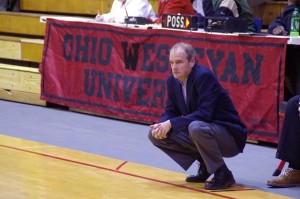
“…Being the regular season champions is, you know, obviously a good thing. We’re on to our next goal now, which is to try to win the conference tournament.”
The men’s team has three consecutive appearances in the NCAA tournament as well, and DeWitt said he hopes for a fourth, which they’ll automatically get if they win the conference tournament.
If they don’t win, they find out if they get an at-large spot March 2.
DeWitt said the team relies greatly from having a wide range of talent; in the regular season four of their five starters averaged more than 12 points a game. Junior post Claude Gray led with 19.8 per game; in this game he had 31 points.
“We have a lot of different weapons, we have a lot of different guys that can do a lot of different things,” DeWitt said. “That’s our biggest strength as a team.”
“I think the best way to describe this group is they are really a true team,” said athletic director Roger Ingles. “You had four different kids this year that were player of the week in the conference – you can’t just shut down one guy.”
What they don’t have a lot of, though, are seniors – there’s one on the whole roster, senior starter Nick Felhaber.
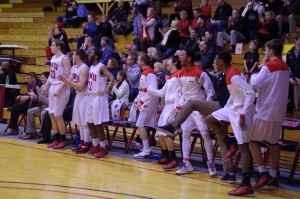
“It’s been interesting, really we’ve got a lot of guys who play like seniors so it doesn’t feel like I’m the only senior,” Felhaber said.
“He’s a great senior, he’s a great leader and we’re going to miss him once he graduates,” DeWitt said about Felhaber.
At the start of the year, Felhaber said, OWU was predicted to finish fourth, so finishing first has been a great experience.
On the other end is starting guard Nate Axelrod, a freshman, but he said the team’s welcomed him into the ranks.
“To be honest, it was a little nerve-wracking…coming into college, new teammates, new players I’m playing against.”
Looking toward the Friday night game, Axelrod said it’d be a “great feeling” to be at home with fellow students behind him and the team.
Ingles added he hopes “a lot of folks from the university” support them, including students. The current Weather Channel forecast puts the Friday night temperature at -7℉, with a 10 percent chance of snow.
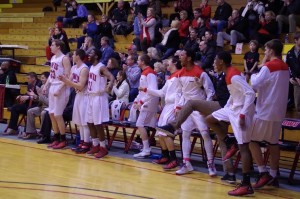
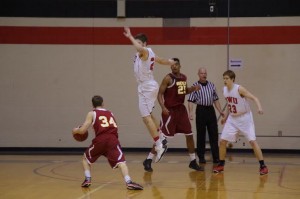
Discussion centered on the issue of how Ohio Wesleyan portrays its message to prospective students at the Monday faculty meeting.
President Rock Jones announced that MindPower Consulting, based in Atlanta, will visit campus next week to meet with faculty and tour the university.
“MindPower is a sharp, clean, forward-thinking firm,” said Susan Dileno, vice president for enrollment.
The goal in bringing in the consulting company is to better present the message of Ohio Wesleyan to prospective students, especially the OWU Connection. Such programs include Theory-to-Practice grants, Travel-Learning courses, Course Connections and student individualized projects.
Jones said this campaign should focus on developing a comprehensive message of what we [the university] are promising students. He said they need to find a way to better present the opportunities in the OWU Connection, especially the student individualized projects (SIPs) because they are more compelling.
Amidst concerns from faculty members about the effectiveness of hiring an outside firm to better tell the message of OWU, Jones said this company will provide expertise and creative thinking and it is not unusual for universities to pursue this route.
He added it has been 10 years since such a comprehensive look from a consulting firm has happened at OWU.
Professor of English David Caplan brought up the concern of cost for hiring MindPower.
Jones said outside of the normally printed publications and yearbooks, the range would be around $200,000.
“I appreciate the candor and depth of thought,” Jones said at the end of his report.
Changes to classes
The Humanities-Classics department split into the comparative literature department and classics program at the end of the spring semester last year, but the course designations stayed the same.
The Academic Policy Committee approved the transitions of formally addressed HMCL classes to the new designation of CMLT and CLAS at the faculty meeting.
Anne Sokolsky, associate professor of comparative literature and head of the department, added that the previously labeled HMCL 124 Love and Sexuality classes will now be four separate course numbers, which allows students to receive credit for taking the class with different professors.
She said each class is completely different from the other and focuses on different locations and literature.
Previously cross-listed courses between botany/microbiology and zoology, such as ZOOL/BOMI 120, will now be addressed as biology courses, BIOL 120. These classes will still count as both botany/microbiology and zoology classes in terms of distribution, according to Paula White, professor of education and chairperson of the Academic Policy Committee.
The faculty also approved the addition of four new permanent additions to the curriculum.
Memorials
Three deceased members of the OWU community were remembered through memorial resolutions.
Verne Edwards died in November 2014. He taught journalism at Ohio Wesleyan for 34 years and was the advisor for The Transcript and had an impressive resume of journalism work in the field.
Chaplain Jon Powers honored Reverend James Leslie who died in October 2014. Leslie was the first full-time chaplain and director of religious life at OWU for 28 years and helped support numerous clubs and organizations at OWU, such as founding the Student Union on Black Awareness (SUBA).
Catherine Schlichting was an honorary alumna who died in July 2014. She worked her way up from a reference librarian at Slocum Library to being the curator for the Ohio Historical Collection. Catherine Cardwell, who read her memorial, commented that she was a source of knowledge for anything about OWU, and the phrase “ask Cay” was often used.

Ohio Wesleyan students, Delaware residents and anyone else interested in Ohio artists may consider stopping by the Ross Art Museum Feb. 24 to April 5.
During this time, 75 pieces by the late central Ohio-based artist Edmund Kuehn will be on display. Announced on the Connect2 OWU blog, the exhibition will be called “Edmund Kuehn: A Retrospective (1937-2011).”
James Keny, co-director of the Keny Art Gallery in Columbus and who represented Kuehn since the 1980s, said the show will have three distinct components, each showing a different phase of Kuehn’s art.
“What we’ve done with the show itself is show the many modes of Keuhn,” Keny said. “He liked that expression. He didn’t like to be confined.”
This includes the two figure paintings that won Kuehn a rare scholarship to the Art Students League of New York in 1937; figure scenes from the 1950s that blend classic elements with modern styles; and small-scale abstractions Kuehn worked on in the later part of his life.
Most are works on paper, painted with acrylics and casein, though a few pieces are oil on canvas. A few works will also be for sale.
Keny said he hopes Kuehn’s displayed works will be inspiring to students and other patrons of the museum.
“He was a very young guy who came from industrial Columbus, scrapped his way through art school…he made a career for himself,” Keny said.
Keny also said he thought Kuehn was a good complement to the liberal arts component at OWU.
“He continued learning, reading, going to galleries,” Keny said.
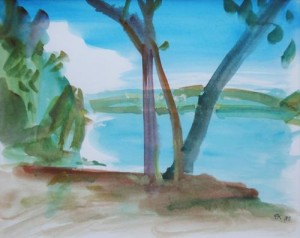
Kuehn was also a teacher of the arts. He taught at the Columbus College of Art and Design (then the Columbus Art School) and curated at the Columbus Gallery of Fine Arts (now the Columbus Museum of Art).
“He was respected for his ability to teach and inform people about modern art,” Keny said. “Which was kind of intimidating in this Midwestern town.”
Keny said he hopes the Kuehn paintings will bring more than just OWU students to the Ross Art Museum.
“Keuhn is a widely collected artist in Ohio,” Keny said. “We’re hoping patrons of his work will be introduced to the Ross. It’s a real treasure not many of them know about.”
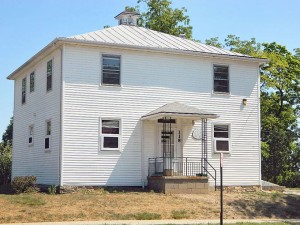
Gathered in the tiny living room inside House of Thought (HoT), all 10 Small Living Unit (SLU) residents got together to express their grievances.
The subject at hand: HoT’s application for renewal was denied, and as a result, the SLU will not be returning.
Senior Todd Zucker, a resident of HoT, said they were told by Residential Life (ResLife) staff that there were several problems with their application.
“We felt that the house has struggled to meet occupancy and complete house projects this year, which indicate their lack of sustainability as a community,” said Wendy Piper, director of ResLife at OWU.
These occupancy concerns, according to the residents of HoT, are unfair.
“We had all of our spaces filled,” said senior Felicia Rose, the house moderator. “Two of our new members had not officially ‘checked-out’ of their old dorms, so they weren’t ‘officially’ residents of HoT when we submitted the application for renewal.”
Rose added that the two new members had tried to contact their Resident Assistants (RAs) to check out of their dorms, but their RAs had not responded to them.
Zucker said the house had seven people last semester.
“We have 10 people living here this semester, and 10 people were lined up to live here next semester,” said Zucker. “Despite all new members knowing that this house was going to be razed, and we wouldn’t have a house.”
Levi Harrel, a residential life coordinator (RLC) and a member of the SLU selection committee, said all SLUs are required to have 100 percent occupancy throughout the entire year.
HoT had only completed two of the required 11 house projects at the end of last semester.
“It was expected that they complete at least half of the required house projects by the end of the first semester,” Harrel said.
Rose says ResLife told her that the house had the entire year to complete their house projects.
Rose said it is hard to know the rules or what ResLife expects from them when there are no written guidelines or rules for SLU members.
Harrel said every member of the SLU community is required to perform one house project per year. House moderators are required to complete two.
Junior Sarah Richmond, a resident of HoT, brought up the point that SLUs are the only non-dorm living option for women.
“Men get to live in a fraternity or a SLU, but women are not allowed to live in the sorority houses, so this is the only place I can live if I don’t want to live in a dorm,” Richmond said.
Replacement SLU?
“Each year, Small Living Units must submit a proposal for renewal and be selected as a SLU for the following year,” said Piper. “Students also have the opportunity to propose new SLUs each year.”
In addition to the HoT’s denial of renewal, a proposal for a new SLU was accepted by ResLife for next year.
The House of Spiritual Athletes (HSA) will be joining the OWU community in the fall, Piper said.
Freshman Conner Brown, one of the founders of HSA, said they will be one of the first SLUs to be completely substance free.
“We will strive for a high standard of maturity and morality, and, as a group, we believe that a substance-free environment is the best way to help us achieve that goal,” said Brown.
The last time a SLU’s application for renewal was denied, according to Piper, was the Creative Arts House in 2010.
“In 2010, the Creative Arts House submitted an application that we initially did not renew on account of our concerns for their physical structures that were located at 110 and 114 Rowland Ave.,” Piper said in an email. “Ultimately, we worked to keep Creative Arts House open amidst certain plans to raze the structures in 2011. The Creative Arts House submitted an application in 2011 but was not renewed. Coincidentally, the last time that we had a SLU that was not renewed and a new SLU that was accepted in its place was when the House of Thought replaced the House of Spirituality in 2003.”
Duplexes on Rowland Ave.
In June of this year, Piper said the university has plans to raze the structure at 118 Rowland Ave.
“We are currently surveying the property and working with a team of architects to determine what the best location will be for newly constructed SLUs,” said Piper. “We hope to have a confirmed site very soon so that we can make plans for construction to commence over the summer.”
Many SLUs are in poor physical condition, according Zucker.
“It usually takes the school about a month to fix something in the house when it is broken,” Zucker said.
Harrel agrees the structures are in poor physical condition.
“It is just time to update the structures, they need it desperately,” Harrel said.
Harrell said the university plans on building a series of duplexes over the next several years to which the SLUs on Rowland Avenue would be relocated.
“It makes sense to start building at 118 Rowland Ave.,” said Harrel, “As it will be the first building to be demolished.”
Ohio Wesleyan’s digital infrastructure, students’ financial obligations and ice cream all made it onto the Wesleyan Council on Student Affairs (WCSA) agenda Monday, Feb. 23.
Junior Emma Drongowski, vice president of WCSA, began her report to the full senate on an economic matter. Due to the fact that “enrollment [is] going down, [but] clubs stay the same,” the administration is beginning talks to increase the student activity fee, a component of OWU’s general tuition statement. This money would go towards supporting the many clubs funded by WCSA.
From money matters, Drongowski moved on to soft-serve ice cream. Requests for ice cream machines have been common over the past few years. Now the potential for an ice cream machine in one or more of the OWU dining facilities is being discussed by executive members of WCSA, something they are “really passionate about.”
The campus relations report focused on a hashtag competition that is currently being organized. The winning prize for the competition, an Amazon gift card, was also announced. A date for the beginning of the competition has not been set.
The campus relations committee made clear their intention of setting up a table in the Hamilton-Williams Atrium. The WCSA senators who man the table will receive feedback from students about proposed changes to the academic calendar. The responses from the Thursday, Feb. 19 tabling were too varied for a consensus to emerge.
Testing is underway for an information technology hotline, aimed at documenting internet outages and dead zones across campus. The number will be distributed after WCSA senators use the service this week on a trial basis. Text messages to the number will be sent to the Information Systems office in an attempt to reduce the wait time on internet-outage repairs.
The final announcement before the full senate adjourned was made by Dean of Students Kimberlie Goldsberry. She reported that the last week to complete a survey on sexual assault began today (Feb. 23). Participation in the survey is now at 24 percent, four percent higher than last Monday’s (Feb. 16) rate.
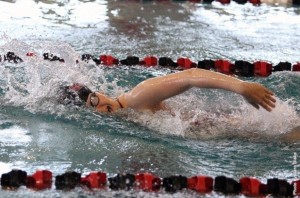
The Ohio Wesleyan men’s and women’s swim teams set new records at the NCAC Conference Championship meet at Denison University Feb. 12 through Feb. 14.
The women’s team set two school records while the men’s team set four school records.
Junior Bryce Uzzolino set two school records in the 50 meter and 100 meter freestyle.
Uzzolino surpassed the 50 meter record of 21.39 seconds with his new time at 21.07 seconds. His time of 46.69 seconds in the 100 meter swim beat the previous record by .02 seconds.
Alongside his fellow team members sophomore Greyson Goodwin, senior Kaneat Nimcharoenwan and junior Andy Cumston, Uzzolino assisted in breaking the 200 meter free relay record of 1:24.64 set in 1992 with 1:24:36. He also beat the 400 free relay record – 3:08.14 – with a time of of 3:07.48.
OWU men’s team placed 7th out of 10 teams and OWU women’s team placed 8th out of 9 teams. Denison came in first place in both men’s and women’s beating out the traditional powerhouse, Kenyon.
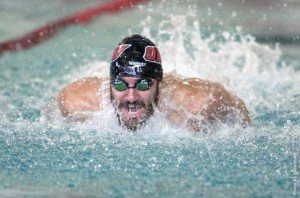
“We fall kind of in the middle in terms of the swim program,” said coach Richard Hawes. “But what we have to understand is that the NCAC is at the very top in the country so we could be in a different conference and win. So, for us to be in the middle is actually quite good. When you look at all the division three swimming programs we are probably in the top 25 percent.”
Before the meet, the men’s and women’s swim teams both sat down and wrote goals for themselves. There were three goals that were consistent between both teams: cheering for each other at the meets, swimming season-best times as well as lifetime-best times, and to break school records.
“100 percent of the teams achieved season best and about 92 percent set lifetime-best times” Hawes said. “They did not disappoint,” Hawes said. “I knew they were going to go fast and they did. They certainly hit every expectation that I had.”
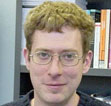
Despite making great deal of progress over the past several decades, Brazil still faces many challenges in its future as a global leader.
James Franklin, professor and chair of the politics and government department at Ohio Wesleyan University spoke about the changes Brazil has seen over the last 50 years in the latest installment of the Great Decisions lecture series.
One challenge Brazil faces is the high level of inequality throughout the country.
“Some people are living in favelas and in slums, and some have walled houses, armed guards and commute to work in a helicopter,” Franklin said.
Franklin said there are high amounts of chaos in the government, likely because its Chamber of Deputies, the Brazilian equivalent to the United States’ Congress, contains more than 28 different political parties.
The government of Brazil had a very authoritarian start; however, it is working toward a successful democracy, he said.
Another contemporary challenge Brazil faces, Franklin said, is the extreme fractionalization of the political parties. “Some political parties don’t even take a stand on many issues,” he said. “They are there because they want power.”
Corruption is another of the challenges Brazil faces. Kickbacks to the oil industry recently, leads many Brazilians to not trust their government.
One connection many South Americans share is their passion for politics, Franklin said. Everyday citizens in Brazil and other parts of South America are much more involved in politics than citizens in the United States.
Another challenge Brazil faces is the protection of the Amazon rainforest. Franklin said the country’s president has reduced deforestation, so much so that the impact on carbon emissions would be “if the entire European Union stopped driving for a whole year.”
But government enforcement in the Amazon is actually quite weak, Franklin said. Until former president Luiz Inacio Lula da Silva, the government didn’t do anything to stop deforestation.
“President Lula actually put in place incentives for Brazilians to not promote the deforestation of the Amazon,” said Franklin. “I might even say Brazil has done the most out of any country to combat global warming.”
Franklin said with poverty being such an extreme issue throughout the country, the issue of protecting the environment is often swept under the rug.
“Economic and financial issues are given far more importance than environmental issues are,” Franklin said.
The biggest challenge Brazil faces now is determining what its role in the world will be as a developing global power.
The next Great Decisions lecture will occur on Friday, Feb. 27, from noon to 1 p.m. at the William Street United Methodist Church. The subject will be “U.S. Policy Toward Africa,” which will feature OWU professor Randolph Quaye.
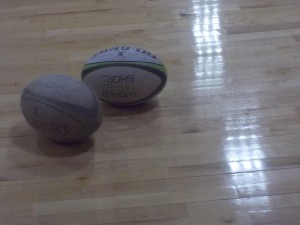
Rugby, an imported sport with a growing following on Ohio Wesleyan campus, is on its way to being an institution.
With the spring season poised to start, both the men’s and women’s club rugby teams report an established coaching staff, growing rosters, and the potential to qualify for national tournaments.
“We’re more competitive,” director of OWU rugby John English said. “Just from last spring to this spring, the biggest change is more students are getting involved.”
Josh Longenbaker, head coach of the women’s team, said there are more than 20 women signed up to play and around 30 for the men’s team. Along with increased players comes increased play, with both teams signed up to play other schools and in tournaments. English said OWU will also host a sevens tournament for both teams.
In rugby, there are two formats of play. The traditional format pits two teams of 15 against each other for two, 40-minute halves while the sevens format narrows the players to seven a side, and the halves to seven minutes. Both teams will play both formats, though Longenbaker said the women’s team will be playing in a sevens league.
Longenbaker said atmosphere is important to getting, and keeping, players new to the sport. Some techniques include running the men’s and women’s practices together and making the drills run like fun games.
“We know everything we do works at a high level so we ask a lot,” Longenbaker said, “but we also try to make it fun.”
English and Longenbaker came to OWU from running a competitive high school program. Also on staff are Cody Albright, coach of the men’s team, and Pat Bowling.
Sophomore Liam McNulty, who formed the men’s club last year, said the coaches’ experience helps create a welcoming atmosphere, essential to helping people “understand the true beauty” of an aggressive sport.
“Other than myself and a handful of others, most members have not played rugby before their college careers,” McNulty said. “Since I started the program, the development of this atmosphere has been crucial.”
McNulty said efforts to recruit are always ongoing – he said players constantly talk about the club, wear the gear to gain visibility and try to get as many students as possible “hooked” by going to the games. Students might have also noticed posters for the women’s club taped around OWU, stating the empowering aspects of playing rugby.
Junior Lauren Kiebler, public relations chair for the women’s club, said it’s well known that the club is inclusive, but it is important to note it is open to non-binary players; the team plays in a trans-inclusive league.
Freshman Bree Riggle said the rugby club was a big reason she chose to come to OWU, though health reasons have prevented her from attending many practices.
“Everyone helps everyone,” Riggle said. “It’s a family. I love it. It’s a great sport.”
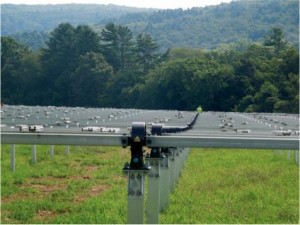
While Denison’s The Denisonian announced the university’s plans to begin building 6,000 solar panels this spring, sustainability efforts at Ohio Wesleyan will not include such a plan.
According to Peter Schantz, director of the physical plant for Buildings and Grounds, it takes two acres of land to generate two megawatts of electricity – land OWU doesn’t have.
“We’ve had several solar power providers approach us, tour our facilities and say we’re not viable,” Schantz said.
Schantz said an alternative way for OWU to save energy is to retrofit the buildings, which includes adding more energy-efficient lighting and energy-saving heating ventilation and air-conditioning. Though Schantz said finding money for such an endeavor is difficult, many of the recent building renovations help.
“Every time our donors give money to renovate, we improve the energy profile of those buildings,” he said.
Elliott Hall counts among one of the recently renovated buildings, while Merrick Hall is in the process of renovation. Schantz said the Small Living Units as well will be updated through the Student Housing Master Plan.
President Rock Jones said in an email that the university makes efforts to support sustainability in other ways as well, such as by working with Chartwells to provide more locally-sourced food, installing “Hydration Stations” to decrease bottled-water usage on campus and using partially-recycled paper for a “print green” program.
Additionally, Jones and Schantz said the campus and the City of Delaware have investigated the possibility of sharing land for solar panels, although finding a workable model has not yet happened.
Both Jones and Schantz said it’s important to see what other schools do to improve their environmental impacts, though the solutions won’t necessarily translate at OWU.
“Each campus is unique,” Jones said. “The size of the campus, the age of its buildings, its geographic location, and many other issues impact its sustainability. Denison, for example, was burning coal until very recently. Ohio Wesleyan converted its power plant in 1989.”
Schantz, who is involved in many of the sustainability initiatives on campus, said the focus should be on OWU’s opportunities.
“Keeping up with anyone else is a bad idea in any regard,” Schantz said. “This is an important pursuit and we need to be focusing on what we can do…how do we use our resources to reach our goals?”